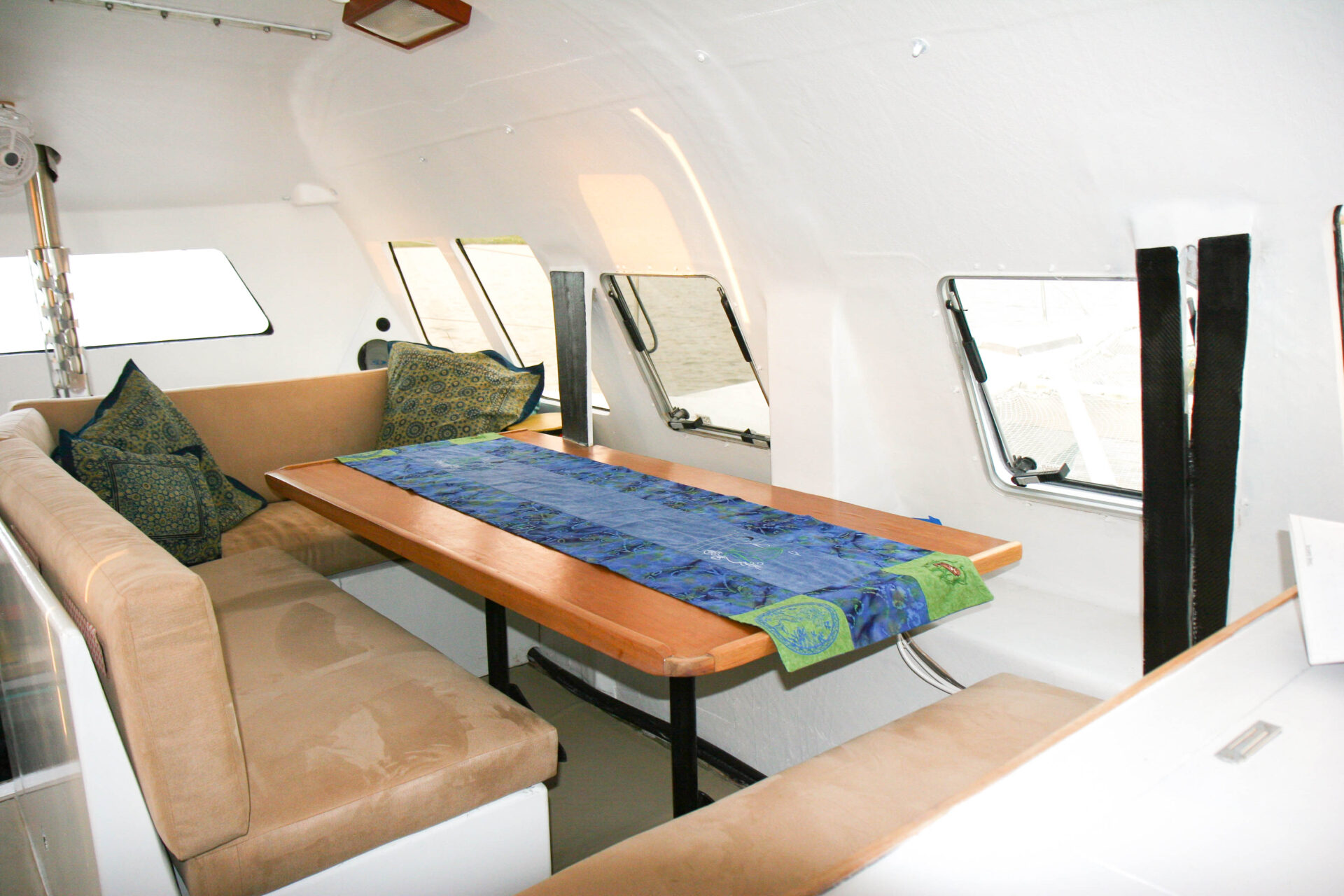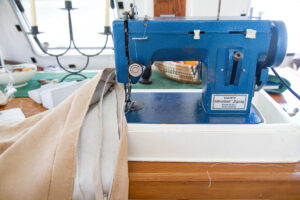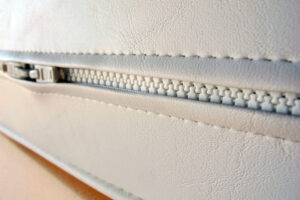When my husband Evan and I were buying our first boat, a then 20-year-old Fortune 30, we sat down at the settee to sign the documents and quickly realized something wasn’t going to work. For me, it was the ugly colour of the scratchy fabric. For Evan it was the fact he was bottoming out on the—who-knows-how-old and I think they might smell a bit funky—cushions.
Happily, Evan’s parents are generous people and as a fantastic boat-warming gift we were given new settee cushions. But, being fairly new to the whole cushion-making process, the only decisions we made were about the colour and design (comfortable, washable fabric with a pattern to hide stains). Beyond that, the materials (fabric, thread, zippers, foam, batting) were selected by the upholsterer.
The cushions were lovely—but it turned out they were better suited to a lightly used cabin or weekend boat—not a liveaboard. The zippers needed replacing after a year, the fabric was too lightweight and tore within two years, and the foam broke down within three.
Fast forward to our current boat life; we now share co-op boats with dozens of other members. While we want the boats to look nice, when it comes time for new cushions our goals are clear: we opt for dense, long-lasting foam and durable, but affordable, fabric covers that can stand up to frequent use.
Fortunately, a few things have changed since we had our first cushions made. Modern marine fabrics, with their increased durability and stain-resistant qualities, now come in an incredible range of colours, patterns and textures. And new types and combinations of foam offer everything from high-density foams with antimicrobial treatments (to inhibit mold and mildew), to eco-friendly natural latex, to easily recyclable foam.
Getting Started
If your cushions are more than 10 to 15 years old, it’s probably worth choosing new foam and getting a fresh start. If you are not sure, take the cushion out of its cover and let it air out. If it smells musty, has mold or is starting to degrade, you’ll probably want new foam.
When it comes to replacing the cushions, you have a lot of options. You can go with a DIY effort and have your foam cut locally and then sew your own covers; opt for mail order service where you do all your own measurements; or hire a full-service upholsterer.
No matter which route you go you need ask yourself a few questions: Do you need high-quality foam that will stand up to frequent use, or will something less expensive work? Is the fabric going to see years of hard use with kids and pets, or summer weekend wear only? Are you refitting the boat for a long cruise, or are you sprucing up the boat before selling it? Do you like the style of your existing cushions, or are they ill-fitting and uncomfortable?
BOX Fabric Tip: If you are planning to sell your boat in the foreseeable future, choose a “saleable” fabric colour such as blue or neutral beige.
Materials
Foam: The most common materials for interior foam are polyurethane and latex. Outside the cabin, you’ll find open-cell, fast dry foams that water can flow through or closed-cell foams which don’t absorb water but can be very firm (and may also float). Most foam companies have their own proprietary names for foam so it can be a bit hard to compare prices—for example the Foam Shop sells the Quickdri Series, a medium-firm foam that doesn’t absorb moisture while the Foam Factory sells Dryfast foam.
Once you decide on a type of foam, you’ll want to look at density and compression. This often translates as firmness and is often listed as pounds per cubic inch (densities for boat cushions are often 1.4 to 1.8). But density also effects how long the foam will last. Higher density foams can go through more cycles of compression (meaning you can sit down or sleep on it more times before it starts to break down). But since really firm, long-lasting foam may not be super comfortable, you might want to consider having softer foam or memory foam glued on to give more of a pillowy feel.
Most upholsterers also wrap polyester or wool batting around the foam before inserting it into your cushion fabric to create that soft, rounded look. Be sure they don’t use too much batting though—it compresses more quickly and can make your cushions look deceptively puffy.
BOX Planning Tip: Think about what you like and don’t like about your current settee before ordering cushions. Do your backrests need more or less back support? Would you prefer flat seats (basically unadorned rectangles), knee rolls, lumbar rolls or maybe other stylized shaping?
Fabric Coverings The other major material decision is on the cushion’s cover. There are some qualities you should look for in boat cabin upholstery fabric. Even though it’s the interior of your boat, there’s still a lot of saltwater around (not to mention sunscreen and sand) so you’ll want to choose a high-performance fabric that can stand up to a marine environment. Look for fabrics that have at least a few of these properties: UV treatment to prevent fading; mold and mildew resistance; abrasion and stain resistance; and ease of cleaning.
Vinyl and synthetic leather are affordable (Sailrite sells several options for under US$25 a yard), durable and easy to clean, but if you’ve ever sat at a vinyl settee on a hot day while wearing shorts or a swimsuit you know about one of its major drawbacks—it can get very sticky and hot.
Fortunately, new vinyl fabrics, including Sunbrella Horizon, address not just the comfort issues but are phthalate-free. Coming in a much wider range of colours and textures than in the past, these soft materials even have stretch to them.
Fabric comes in a very large variety of patterns, colours and materials. There are stain-resistant fabrics, water-resistant fabrics and polyurethane fabrics that look and perform similar to vinyl but without the environmental issues. Patterned fabrics tend to help hide damage such as stains or holes while plain fabric can help a boat feel less cluttered.
Sunbrella continues to be the leader in marine fabrics and has continued to expand options for patterns and colours but you can also look at other indoor/outdoor brands like Bella-Dura and Covington Outdoor.
BOX Design Tip: Some fabric designs may not suit your cushions (geometrics can look strange on curved shapes for example) so be sure to decide on the design of the cushion shape before choosing the fabric pattern.
The Process
Once you’ve narrowed down your foam and fabric choices, it’s time to decide how to get your new cushions made.
Completely DIY
If your current cushions are fairly straightforward and you have some sewing skills, a good quality sewing machine and some time on your hands, tackling cushions as a DIY project is actually pretty simple. JT’s Outdoor Fabrics has a range of tools and supplies you might need for this kind of project, while the Foam Factory has a good tutorial on how to measure and cut the foam.
Some people fear making their own cushions because the fitting can be finicky and misfit cushions look really bad. Then there’s the fact the pieces are quite large, and the material can be heavy, which requires a sturdier-than-average sewing machine. In some cases, the material itself is quite expensive, so making an error becomes quite costly.
With our first boat I used the old cushion covers to make a new pattern and the old foam as a guide when cutting new foam from one big sheet. Two of the cushions had hardly seen any use—so I just re-used that foam. I also went with a less expensive Sunbrella—so when I made one cushion completely backwards, the wasted fabric wasn’t such a loss. I’m not the world’s quickest seamstress but we completed the project over one long weekend.
BOX DIY Tip: take a sewing or upholstery class at a community college and use your settee cushions as your class project. You’ll get access to better machines and expert help.
Mail Order or Hybrid
If you are not keen on sewing your cushions yourself—or simply have a project that’s more complex than you can manage—another money-saving option is to work with a mail-order company. Companies such as FoamOrder.com have websites where you choose everything from the fabric and foam to the cushion shape and thickness. They carry patterns for many boat models or can supply new customers (from all over the world) with a pattern-making kit and instructions that basically allow you to do the job of stencilling out your cushions with the same tools as the pros.
Canadian companies including the Foam Factory also have a good online ordering system where you can order custom foam based on the shape. You can then sew your own covers or hire someone for the job.
Full-Service Upholsterer
The third option is to go with a full-service local upholsterer. This can be a great choice if you want a little more advice and guidance with your options. Often a consultant will show up at your boat with a variety of fabric catalogues and foam samples and then help you to look at your material choices in the context of your boat. In our case the upholsterer was able to point out the high-use sections of our cushions (and suggest ways to build them to stand up to the added abuse), advised us what fabrics might work best for our lifestyle and showed us exactly what the fabric colour we chose would look like with our other décor. Then she measured the settee, made paper patterns and a few weeks later returned and fit our lovely new cushions. Estimates vary but you should expect to pay 20 to 50 percent more for full-service above the cost of mail order or DIY. Before tossing your old foam, check with your foam supplier to see if they will take it for recycling. The Foam Shop repurposes old foam as carpet underlay after cleaning and sterilization.
New cushions can be a big investment, so it makes sense to research the project well and get exactly what you want and need for your boating lifestyle. Be sure the fabric and foam are the right type and quality for your use—and don’t forget the zippers. Be sure to choose heavy duty marine grade zippers that will work in a saltwater environment. We’ve learned this one, finally. But no matter what materials you choose or how you get your new cushions made, one thing is for sure—increased comfort and pride in your boat.


